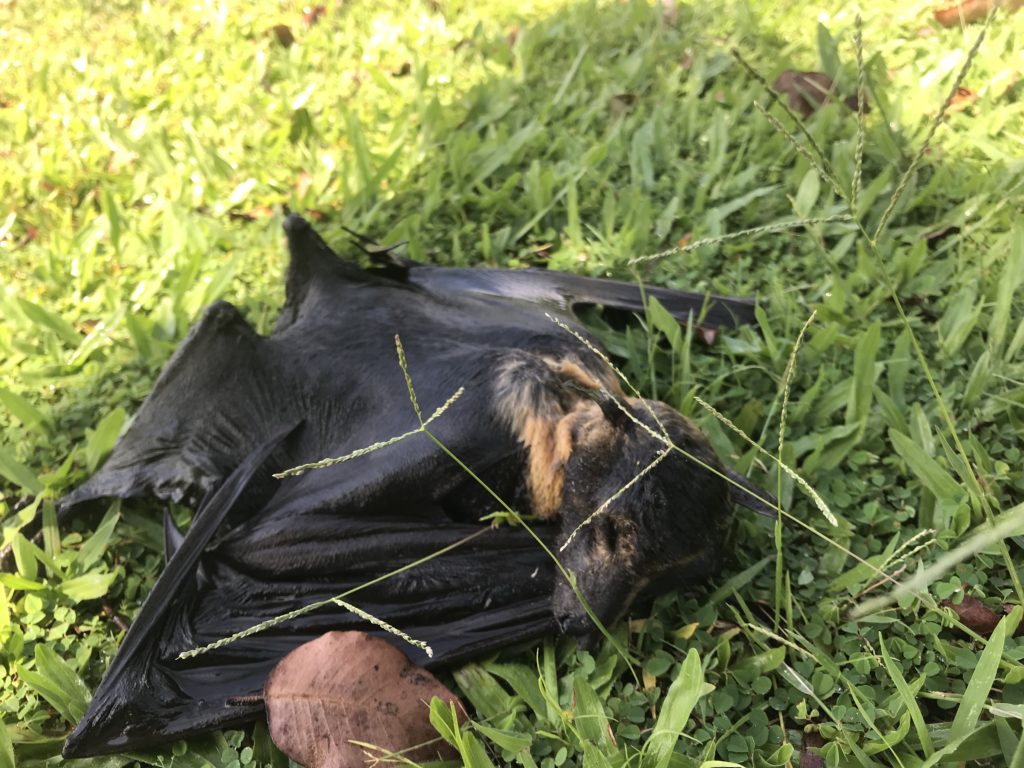Bat virus risk to Ingham residents

A dead bat in Ingham’s Botantical Gardens this week.
HINCHINBROOK MP Nick Dametto has urged Ingham residents to remain vigilant around a flying fox roost plaguing the town in light of recent health warnings.
Mr Dametto echoed calls by Townsville Hospital and Health Service public health physician Dr Steven Donohue not to approach bats in order avoid being bitten or scratched and potentially contracting Australian bat lyssavirus.
“Unfortunately, we’ve got a State Government who is telling us we need to live with bats and while we work on a solution to disperse this roost in Ingham, people should stay well away from these creatures,” Mr Dametto said.
“The bat colony at Ingham Botanical Gardens is close to Ingham State School, Our Lady of Lourdes Catholic Primary School and Hinchinbrook Aquatic Centre. It’s critical our school children remain as safe as possible in these last few weeks of term before holidays.”
Mr Dametto said he continued to work with all stakeholders, including Hinchinbrook Shire Council and State Environment Minister Leeanne Enoch’s office, in trying to find a long-term solution to removing the local bat colony.
Mr Dametto has also met with Biodiversity Australia, who are currently working with Charter Towers Regional Council on their bat problem, and has passed on their details to Hinchinbrook Shire mayor Ramon Jayo.
“I understand how frustrating this problem is for local residents and as I’ve said before, I’m open to any non-lethal solution out there which could be used to get rid of these bats,” Mr Dametto said.
“Any method we choose has to not only drive the bats away but push them towards an area where they won’t disturb or inconvenience someone else.”
Several innovative ideas from residents had already been proposed, including using a drone to scare and muster the roost, establishing birds of prey nests in the area and even unleashing green ants to get flying foxes out of the trees.
The current Code of Practice governing the “Ecologically sustainable management of flying-fox roosts” permits councils to destroy a flying fox roost, drive away or attempt to drive away a flying fox from a roost and disturb a flying fox in a roost – all of which are restricted to non-lethal deterrence methods.
Those methods extend to use of smoke, noise, light, foggers, BirdFrite and “scarecrow” type devices.
Australian bat lyssavirus infection in humans causes a serious illness which results in paralysis, delirium, convulsions and death.
A rabies vaccine that is given after exposure to the virus, but before a person becomes unwell, will prevent the disease. However once a person develops the disease there is no specific treatment for the virus.
If you are bitten or scratched by a bat, immediately wash the wound thoroughly with soap and water for at least five minutes. If available, an antiseptic with anti-virus action such as povidone-iodine or alcohol (ethanol) should be applied after washing.
If bat saliva contacts the eyes, nose or mouth, flush the area thoroughly with water for several minutes.
Seek medical advice about the need for rabies vaccination as soon as possible, preferably on the same day, or early in the day after the exposure to the bat occurred.
A tetanus injection may also be necessary after a bat bite or scratch.
While bat faeces, urine and blood are not considered to pose a risk of Australian bat lyssavirus, contact with any bat fluids should generally be avoided.
If you have any contact with bat fluids, wash your hands (or other affected areas) immediately.





